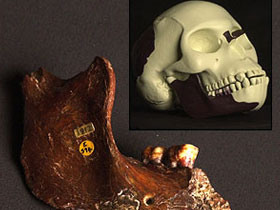 The Piltdown Man fossil that deceived the world of science for some 40 years was actually a fraud concocted by evolutionists putting together bones of a man and an ape. |
In 1912, Charles Dawson, a famous doctor and also an amateur paleontologist, claimed to have discovered a jawbone and part of a skull in a gravel pit near the village of Piltdown in England. Although the jawbone resembled that of an ape, the teeth and skull resembled those of human beings. These specimens were given the name of Piltdown Man, an age of 500,000 was estimated for them, and they were exhibited in various museums as incontrovertible proof of evolution. For some 40 years, they were the subject of many scientific papers, analyses and reconstructions. Some 500 academics from various universities all over the world prepared doctoral theses on the subject of Piltdown Man.181
On a visit to the British Museum in 1935, the famous American paleoanthropologist H.F. Osborn proclaimed Piltdown "a discovery of transcendent importance to the prehistory of man,"and added, "We have to be reminded over and over again that nature is full of paradoxes …"182
 A depiction of Piltdown Man, based on the fraudulent fossil |
In 1949, Kenneth Oakley of the British Museum's Paleoanthropology Department sought permission to perform a new dating technique, the fluoride test, on some old fossils. When it was carried out on the Piltdown Man fossil, it was revealed that the jawbone contained no fluoride. This showed that it had been underground for no more than a few years. The skull contained a low level of fluoride, making it only a few thousand years old.
Subsequent chronological investigations based on the fluoride method confirmed that the skull was only a few thousand years old. It was also realized that the teeth had been artificially abraded, and that the primitive artifacts found alongside the fossils were mere reproductions, made with modern steel implements.183
With the detailed analyses performed by Weiner, this fraud was definitively revealed in 1953. The skull was 500 years old and human, and the jaw belonged to a newly dead orangutan! The teeth had been added later, and their joints abraded to give the impression they were human. Later, all the parts had been stained with potassium dichromate to give them an aged appearance. When the bones were placed in acid, the stains disappeared.
Le Gros Clark, a member of the team that uncovered the fraud, was unable to mask his astonishment: "the evidences of artificial abrasion immediately sprang to the eye. Indeed so obvious did they seem it may well be asked-- how was it that they had escaped notice before?"184
181. Malcolm Muggeridge, The End of Christendom, Grand Rapids: Eerdmans, 1980, p. 59.
182. Stephen Jay Gould, "Piltdown Revisited," Natural History, March 1979, p. 98.
183. Kenneth Oakley, William Le Gros Clark & J. S, "Piltdown," Meydan Larousse, Vol. 10, p. 133.
184. Stephen Jay Gould, "Smith Woodward's Folly," New Scientist, p. 444.


